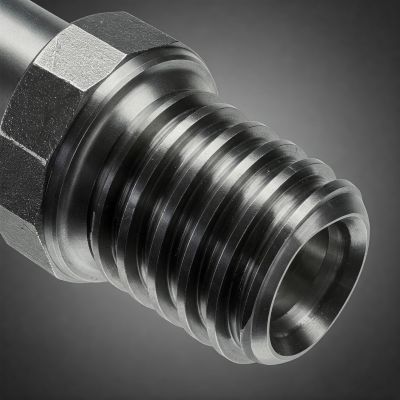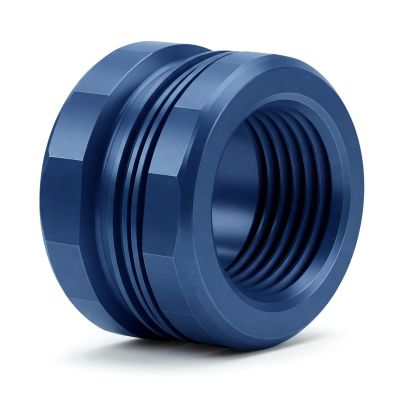Threaded connections are an essential part of many industries, including plumbing, machinery, and construction. They provide a secure and reliable way to join components together, ensuring a strong and stable connection. Understanding the difference between male and female threads is crucial for selecting the right fasteners and fittings for any application.
In this article, we will explore the key differences between male and female threads, their applications, identification methods, and common troubleshooting tips.
What Are Threads?
Threads are helical structures cut or formed on the inside or outside of a cylindrical surface, enabling components to be screwed together. They serve two main purposes:
➡️ Fastening: Threads provide a secure way to join two parts together.
➡️ Sealing: In plumbing and piping, threaded connections help prevent leaks when used with appropriate sealing materials.
Male Threads vs. Female Threads
Male Threads
Male threads are external threads that are cut or rolled onto a cylindrical rod or pipe. They are designed to fit into a corresponding female thread.
Common Uses:
➡️ Bolts and screws
➡️ Pipe fittings (e.g., Male Iron Pipe – MIP)
➡️ Fasteners in construction and automotive applications
Examples of Male Thread Types:
➡️ Standard bolts
➡️ Pipe nipples
➡️ Studs and threaded rods
Female Threads
Female threads are internal threads found inside a hole or cylindrical opening. They are designed to accept male threads for a secure fit.
Common Uses:
➡️ Nuts
➡️ Pipe couplings and fittings
➡️ Threaded inserts for machinery and furniture
Examples of Female Thread Types:
➡️ Hex nuts
➡️ Pipe couplings
➡️ Threaded sockets
How Male and Female Threads Work Together
Male and female threads interlock by twisting together, allowing for a secure and stable connection. Proper threading is crucial for achieving a tight fit, preventing leaks, and ensuring structural integrity.
Important Considerations:
➡️ Thread Tolerance: Ensuring that the male and female threads match correctly in terms of pitch and diameter.
➡️ Thread Compatibility: Mixing different thread standards can lead to improper fitting and leaks.
Different Types of Thread Standards
Various thread standards exist to accommodate different applications. Some of the most common include:
NPT (National Pipe Thread)
➡️ Common in North American plumbing and piping applications.
➡️ Tapered design for a tight seal.
BSP (British Standard Pipe)
➡️ Used in European and Asian markets.
➡️ Available in both parallel (BSPP) and tapered (BSPT) versions.
UN/UNC (Unified National Coarse/Fine)
➡️ Standard for bolts and fasteners in North America.
➡️ Coarse (UNC) threads are used for general applications, while fine (UNF) threads provide a stronger hold.
Metric Threads
➡️ Commonly used internationally.
➡️ Measured in millimeters, with pitch indicating thread spacing.
How to Identify Male and Female Threads
Visual Inspection Techniques:
➡️ Male threads protrude outward, while female threads are recessed inward.
Measuring Thread Size and Pitch:
➡️ Use a caliper to measure the diameter.
➡️ A thread gauge helps determine pitch (spacing between threads).
Tools for Identifying Threads:
➡️ Thread pitch gauge
➡️ Calipers
➡️ Thread identification charts
Common Applications of Male and Female Threads
Plumbing Systems:
➡️ Used in pipes, faucets, and fittings.
Fasteners (Bolts and Nuts):
➡️ Essential for construction, automotive, and machinery applications.
Machinery and Automotive Parts:
➡️ Threads allow for secure assembly and disassembly of machine components.
Industrial and Manufacturing Equipment:
➡️ Utilized in heavy-duty machinery and structural assemblies.
Tips for Choosing the Right Thread Type
➡️ Match Male and Female Threads: Ensure compatibility in size and pitch.
➡️ Check Thread Standards: Avoid mixing different thread types.
➡️ Use Sealants and Teflon Tape: Helps prevent leaks in plumbing applications.
Common Issues and Troubleshooting
Cross-Threading:
➡️ Occurs when threads do not align properly.
➡️ Solution: Start threading by hand before using tools.
Stripped Threads:
➡️ Happens when threads are damaged or worn out.
➡️ Solution: Use thread repair kits or inserts.
Leaks in Plumbing Threads:
➡️ Solution: Apply thread tape or sealant to ensure a tight seal.
Conclusion
Understanding the difference between male and female threads is crucial for selecting the right components for various applications. Proper identification, compatibility, and installation ensure a secure connection and prevent issues such as leaks and cross-threading.
By following best practices and using the right tools, you can ensure that your threaded connections remain strong and reliable.
Post time: Mar-21-2025



